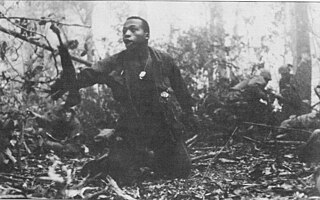
The battle of Dak To in Vietnam was a series of major engagements of the Vietnam War that took place between 3 and 23 November 1967, in Kon Tum Province, in the Central Highlands of the Republic of Vietnam. The action at Đắk Tô was one of a series of People's Army of Vietnam (PAVN) offensive initiatives that began during the second half of the year. PAVN attacks at Lộc Ninh, Song Be and at Con Thien and Khe Sanh,, were other actions which, combined with Đắk Tô, became known as "the border battles". The post hoc purported objective of the PAVN forces was to distract American and South Vietnamese forces away from cities towards the borders in preparation for the Tet Offensive.
The lead-up to the Battle of Kontum began in mid-1971, when North Vietnam decided that its victory in Operation Lam Son 719 indicated that the time had come for large-scale conventional offensives that could end the war quickly. The resulting offensive, planned for the spring of 1972, would be known as the Easter Offensive in the South and the Nguyen Hue Offensive in the North, Nguyen Hue being a hero of Vietnamese resistance against the Chinese in 1789. The Easter Offensive would make use of fourteen divisions and would be the largest in the war.
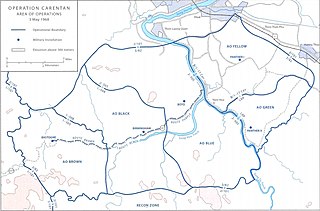
Operation Carentan and Operation Carentan II were security operations conducted during the Vietnam War by the U.S. 1st and 2nd Brigades, 101st Airborne Division and the 3rd Brigade, 82nd Airborne Division in Thừa Thiên Province, South Vietnam from 18 March to 17 May 1968.
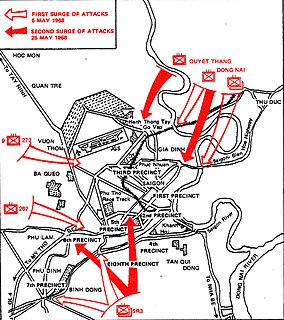
Phase Two of the Tet Offensive of 1968 was launched by the People's Army of Vietnam (PAVN) and Viet Cong (VC) against targets throughout South Vietnam, including Saigon from 29 April to 30 May 1968. The May Offensive was considered much bloodier than the initial phase of the Tet Offensive. US casualties across South Vietnam were 2,169 killed for the entire month of May making it the deadliest month of the entire Vietnam War for U.S. forces, while South Vietnamese losses were 2,054 killed. PAVN/VC losses exceeded 24,000 killed and over 2,000 captured. The May Offensive was a costly defeat for the PAVN/VC.
Operation Texas Star was a military operation of the Vietnam War that took place in Quảng Trị and Thừa Thiên Provinces from 1 April to 5 September 1970.

The 22nd Division of the Army of the Republic of Vietnam (ARVN) was part of the II Corps that oversaw the region of the Central Highlands north of the capital Saigon. The 22nd Division was based in Ba Gi near the south central coast.
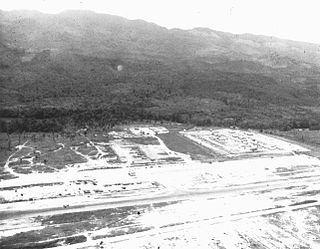
Đắk Tô Base Camp is a former U.S. Army and Army of the Republic of Vietnam (ARVN) base northwest of Kon Tum in the Central Highlands of Vietnam.
Ben Het Camp is a former U.S. Army and Army of the Republic of Vietnam (ARVN) base northwest of Kon Tum in the Central Highlands of Vietnam. The camp was notable for being the site of a tank battle between the U.S. Army and the People's Army of Vietnam (PAVN), one of the few such encounters during the Vietnam War.

Operation Double Eagle was a US Marine Corps and Army of the Republic of Vietnam (ARVN) operation that took place in southern Quảng Ngãi Province, lasting from 28 January to 17 February 1966, during the Vietnam War. The operation was mounted in conjunction with Operation Masher in northern Bình Định Province. The operation was inconclusive as the People's Army of Vietnam (PAVN) and the Vietcong (VC) had largely slipped away.
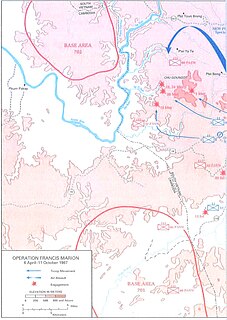
Operation Francis Marion was a 4th Infantry Division and 173rd Airborne Brigade operation that took place in Pleiku, Darlac and the Kon Tum Provinces, South Vietnam, lasting from 6 April to 11 October 1967.

Operation Napoleon/Saline was a multi-Battalion operation conducted by the United States Marine Corps and the United States Army along the Cửa Việt River south of the DMZ in Quảng Trị Province. The operation ran from 20 January to 9 December 1968.

The Battle of the Slopes was the site of an engagement between elements of the 173rd Airborne Brigade (Separate), nicknamed "Westmoreland's Fire Brigade" and People's Army of Vietnam (PAVN) units, as part of Operation Greeley.
The Battle of Trung Nghia took place from 8 June to 16 September 1973 when North Vietnamese forces captured the village of Trung Nghia in the Central Highlands of South Vietnam. The North Vietnamese were eventually forced out by the South Vietnamese.
The Battle of Quang Duc took place from 30 October to 10 December 1973 when North Vietnamese forces attempted to occupy part of Quang Duc Province to expand their logistical network from Cambodia into South Vietnam. While the North Vietnamese attacks were initially successful they were eventually forced out by the South Vietnamese.
Operation Nevada Eagle was a security operation during the Vietnam War in Thừa Thiên Province, that took place from 17 May 1968 to 28 February 1969.
Operation Lamar Plain was a security operation during the Vietnam War in Quảng Tín Province, that took place from 15 May to 14 August 1969.
Operation Massachusetts Striker was a joint U.S. Army and Army of the Republic of Vietnam (ARVN) military operation during the Vietnam War designed to keep pressure on the People's Army of Vietnam (PAVN) units in the southern A Sầu Valley and prevent them from mounting any attacks on the neighboring coastal provinces.
Operation Clinch Valley was a joint U.S. Army and Army of the Republic of Vietnam (ARVN) military operation during the Vietnam War to engage People's Army of Vietnam (PAVN) units on the Khe Sanh plateau and prevent them from reinforcing PAVN units in the A Sầu Valley.
Operation Randolph Glen was a joint U.S. Army and Army of the Republic of Vietnam (ARVN) military operation during the Vietnam War designed to keep pressure on the People's Army of Vietnam (PAVN) units in Thừa Thiên Province and prevent them from mounting any attacks on the populated coastal regions.
Operation MacArthur was a United States Army military operation in the Central Highlands of South Vietnam from 12 October 1967 to 31 January 1969. The early phases of the operation encompassed the Battle of Dak To from 3 to 23 November 1967.










